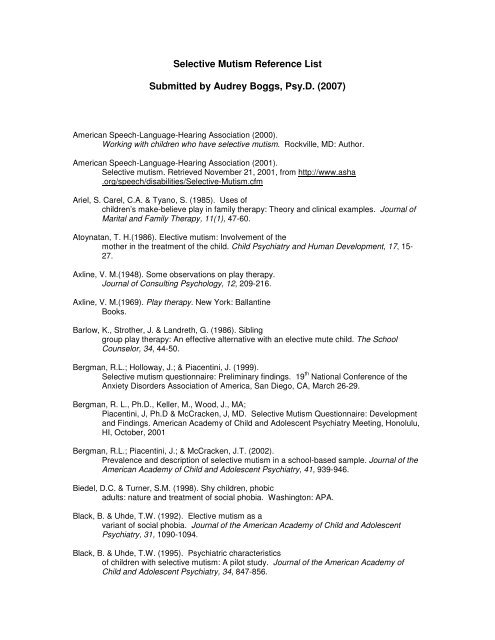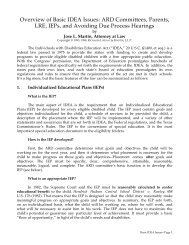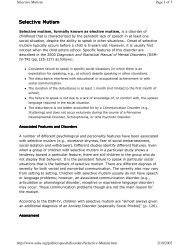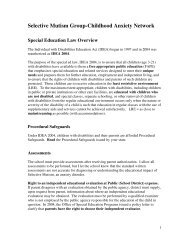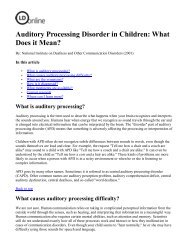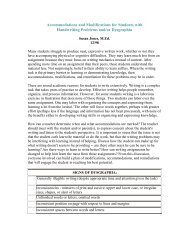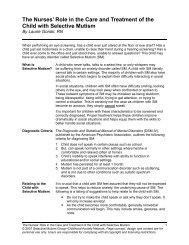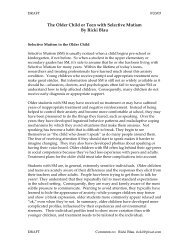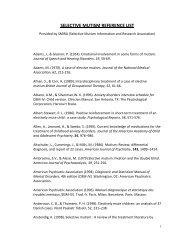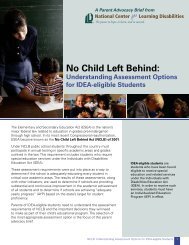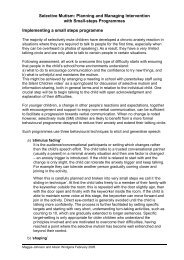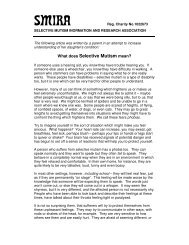Selective Mutism Reference List Submitted by Audrey Boggs Psy.D (2007)
SM Reference List from Audrey Boggs - Selective Mutism Group
SM Reference List from Audrey Boggs - Selective Mutism Group
Create successful ePaper yourself
Turn your PDF publications into a flip-book with our unique Google optimized e-Paper software.
<strong>Selective</strong> <strong>Mutism</strong> <strong>Reference</strong> <strong>List</strong><strong>Submitted</strong> <strong>by</strong> <strong>Audrey</strong> <strong>Boggs</strong>, <strong>Psy</strong>.D. (<strong>2007</strong>)American Speech-Language-Hearing Association (2000).Working with children who have selective mutism. Rockville, MD: Author.American Speech-Language-Hearing Association (2001).<strong>Selective</strong> mutism. Retrieved November 21, 2001, from http://www.asha.org/speech/disabilities/<strong>Selective</strong>-<strong>Mutism</strong>.cfmAriel, S. Carel, C.A. & Tyano, S. (1985). Uses ofchildren’s make-believe play in family therapy: Theory and clinical examples. Journal ofMarital and Family Therapy, 11(1), 47-60.Atoynatan, T. H.(1986). Elective mutism: Involvement of themother in the treatment of the child. Child <strong>Psy</strong>chiatry and Human Development, 17, 15-27.Axline, V. M.(1948). Some observations on play therapy.Journal of Consulting <strong>Psy</strong>chology, 12, 209-216.Axline, V. M.(1969). Play therapy. New York: BallantineBooks.Barlow, K., Strother, J. & Landreth, G. (1986). Siblinggroup play therapy: An effective alternative with an elective mute child. The SchoolCounselor, 34, 44-50.Bergman, R.L.; Holloway, J.; & Piacentini, J. (1999).<strong>Selective</strong> mutism questionnaire: Preliminary findings. 19 th National Conference of theAnxiety Disorders Association of America, San Diego, CA, March 26-29.Bergman, R. L., Ph.D., Keller, M., Wood, J., MA;Piacentini, J, Ph.D & McCracken, J, MD. <strong>Selective</strong> <strong>Mutism</strong> Questionnaire: Developmentand Findings. American Academy of Child and Adolescent <strong>Psy</strong>chiatry Meeting, Honolulu,HI, October, 2001Bergman, R.L.; Piacentini, J.; & McCracken, J.T. (2002).Prevalence and description of selective mutism in a school-based sample. Journal of theAmerican Academy of Child and Adolescent <strong>Psy</strong>chiatry, 41, 939-946.Biedel, D.C. & Turner, S.M. (1998). Shy children, phobicadults: nature and treatment of social phobia. Washington: APA.Black, B. & Uhde, T.W. (1992). Elective mutism as avariant of social phobia. Journal of the American Academy of Child and Adolescent<strong>Psy</strong>chiatry, 31, 1090-1094.Black, B. & Uhde, T.W. (1995). <strong>Psy</strong>chiatric characteristicsof children with selective mutism: A pilot study. Journal of the American Academy ofChild and Adolescent <strong>Psy</strong>chiatry, 34, 847-856.
Brown, J.B. & Lloyd, H. (1975). A controlled study ofchildren not speaking at school. Journal of Associated Workers of Maladjusted Children,3, 49-63.Browne, E.; Wilson, V.; Laybourne, P.C. (1963). Diagnosisand treatment of elective mutism in children. Journal of the American Academy of Child<strong>Psy</strong>chiatry, 2, 605-617.Chavira, D.A.; Shipon-Blum, E.; & Stein, M.B. (2005,March). A family history study of selective mutism. Poster session presented at theannual Anxiety Disorders Association of America Conference, Seattle, WA.Colligan, R. W., Colligan, R. C., & Dillard, M. K. (1977).Contingency management in the classroom treatment of long-term elective mutism: Acase report. Journal of School <strong>Psy</strong>chology, 15, 9-17.Cunningham, C. E., Catalido, M. F., Mallion, C. & Keyes, J.B. (1983). A review and controlled single case variation of behavioral approaches to themanagement of selective mutism. Child and Family Behavior Therapy, 5, 25-49.Davidson, (1993). In Kronenberger & Meyer (1996). Thechild clinician’s handbook. Needham Heights, MA: Allyn & Bacon.DeMaria, T.L. (2003, July). Sensory integration dysfunctionand selective mutism. Presentation delivered at the annual <strong>Selective</strong> <strong>Mutism</strong>Group~Childhood Anxiety Network Conference, Trevose, PA.Dorfman, K. (2004, July). Nutrition and anxiety.Presentation delivered at the annual <strong>Selective</strong> <strong>Mutism</strong> Group~Childhood Anxiety NetworkConference, Baltimore, MD.Dow, S.P.; Sonies, B.C.; Scheib, D.; Moss, S.E.; & Leonard,H. (1995). Practical guidelines for the assessment and treatment of selective mutism.Journal of the American Academy of Child and Adolescent <strong>Psy</strong>chiatry, 34, 836-846.Dummit, E.S.; Klein, R.G.; Tancer, N.K.; Asche, B.; Martin,J.; & Fairbanks, J.A. (1997). Systematic assessment of 50 children with selectivemutism. Journal of the American Academy of Child and Adolescent <strong>Psy</strong>chiatry, 36, 653-660.Dunn, L.M. & Dunn, L.M. (1997). Peabody Picture VocabularyTest-III. Circle Pines, MN: American Guidance Services.Elson, A.; Pearson, C.; Jones, C.D.; & Schumacher, E.(1965). Follow up study of childhood elective mutism. Archival of General <strong>Psy</strong>chiatry,13, 182-187.Friedman, R., & Karagan, N. (1973). Characteristics andmanagement of elective mutism in children. <strong>Psy</strong>chology in the Schools, 10, 249-252.Fundudis, T., Kolvin, I., & Garside, R. F. (1979). Speechretarded and deaf children: Their psychological development. London: Academic Press.
Giddan, J.J.; Ross, G.J.; Sechler, L.L., & Becker, B.R.(1997). <strong>Selective</strong> mutism in elementary school: Multidisciplinary interventions.Language, Speech and Hearing Services in Schools, 28, 127-133.Gil, E. (1991). The healing power of play: Working withabused children. New York: Guilford Press.Gil, E. (1994). Play in family therapy. New York: Guilford Press.Goll, K. (1979). Role structure and subculture in familiesof elective mutists. Family Process, 18, 55-68.Goodman, J.D. & Sours, J.A. (1998). The child mental statusexamination. Northvale, NJ: Jason Aronson.Graham, P. (Ed.). (1998). Cognitive-behaviour therapy forchildren and families. New York: Cambridge University Press.Graczyk, P.A. (2005, March). Working with the schools. In <strong>Selective</strong><strong>Mutism</strong>: Breaking the barrier of silence. Symposium conducted atthe annual Anxiety Disorders Association of America Conference,Seattle, WA.Griff, M.D. (1983). Family Play Therapy. In C.E. Schaefer & K.J.O’Connor (Eds.), Handbook of play therapy (pp. 65-75). New York:Wiley.Gross, S.A. (2003). <strong>Selective</strong> mutism and communication anxiety inchildren. Retrieved April 8, 2003 fromhttp://www.advanceforspanda.com/spfav/spfav15.html.Harris, H.F. (1996). Elective mutism: A tutorial. Language, Speechand Hearing Services in Schools, 27, 10-15.Hayden, T.L. (1980). Classification of elective mutism. Journal ofthe American Academy of Child and Adolescent <strong>Psy</strong>chiatry, 19, 118-133.Herjanic & Campbell, (1977). Diagnostic Interview for Children andAdolescents—Parent Version.Hesselman, S. (1983). Elective mutism in children. ActaPaedopsychiatry, 49, 297-310.Heward, W. L., & Orlansky, M. D. (1992). Exceptional children. NewYork: Macmillan.Irwin, E.C. & Malloy, E.S. (1975). Family puppet interview. FamilyProcess, 14, 170-191.Kaduson, H. & Schaefer, C. (Eds.). (1997). 101 favorite play therapytechniques. Northvale, NJ: Jason Aronson.Kaduson, H. & Schaefer, C. (Eds.). (2000). Short-term play therapy forchildren. New York: Guilford Press.Keith, D.V., & Whitaker, C.A. (1981). Play therapy: A paradigm for work
with families. Journal of Marital and Family Therapy, 7, 243-254.Kendall, P.C.; Kane, M.T.; Howard, B.L.; & Siqueland (1989). Cognitivebehavioraltherapy for anxious children: Treatment manual.Available from the first author, <strong>Psy</strong>chology Department, Temple University, Philadelphia,PA.Kranowitz, C.S. (1998). The out-of-sync child: Recognizing and copingwith sensory integration dysfunction. New York: Skylight Press.Kranowitz, C.S. (2004). Helping the out-of-sync child at home andschool. Presented at the, Balti annual <strong>Selective</strong> <strong>Mutism</strong> Group~Childhood AnxietyNetwork Conference more, MD.Kratochwill, T.(1981). <strong>Selective</strong> mutism: implications for research andtreatment. Hillsdale, NJ: Erlbaum.Kristensen, H. (2001). MCMI-II personality traits and symptom traits inparents of children with selective mutism: A case-control study. Journal of Abnormal<strong>Psy</strong>chology, 110, 648-652Kristensen, H. (2001). Multiple informants’ report of emotional andbehavioural problems in a nation-wide sample of selective mute children and controls.European Child and Adolescent <strong>Psy</strong>chiatry, 10, 135-142.Kronenberger, W.G. & Meyer, R.G. (1996). The child clinician’shandbook. Needham Heights, MA: Allyn & Bacon.Krysanski, V.L. (2003). A brief review of selective mutism literature.The Journal of <strong>Psy</strong>chology, 137, 29-40.Kumpulainen, K. (2002). Phenomenology and treatment of selectivemutism. CNS Drugs 2002, 16, 175-180.Kupietz, S.; & Schwartz, I. (1982). Elective mutism: Evaluation andtreatment of three cases. New York State Journal of Medicine, 7, 1073-1076.Landreth, G. L., Homeyer, L. E., Glover, G., & Sweeney, D. S. (Eds.).(1996). Play therapy interventions with children’s problems. Northvale, NJ: JasonAronson.Landreth, G.L. (Ed.).(2001). Innovations in play therapy: Issues,Process, and special populations. Philadelphia: Brunner-Routledge.Langley, A.K.; Bergman, R.L.; & Piacentini, J.C. (2002). Assessmentof childhood anxiety. International Review of <strong>Psy</strong>chiatry, 14, 102-113.Leonard, H. & Dow, S. (1995). In Anxiety disorders in children andadolescents, March, J.S. (ed.). New York: Guilford.MacGregor, R.; Pullar, A.; & Cundall, D. (1994). Silent at school:Elective mutism and abuse. Archival of Disabled Children, 70, 540-541.Markway, B. G., Carmin, C. N., Pollard, C. A., & Flynn, T. (n.d.).Dying of embarrassment: Help for social anxiety and phobia. Oakland, CA: NewHarbinger.
Mendlowitz, S.L.(2005, March). <strong>Selective</strong> mutism: when cognitivebehavioraltherapy isn’t enough. In <strong>Selective</strong> <strong>Mutism</strong>: Breaking the barrier of silence.Symposium conducted at the annual Anxiety Disorders Association of AmericaConference, Seattle, WA.Meijer, A. (1979). Elective mutism in children. Israel AnnualDisciplines, 17, 93-100.<strong>Psy</strong>chiatry and RelatedMeyers, S.V. (1984). Elective mutism in children: A family systemsapproach. The American Journal of Family Therapy, 12, 39-45.Morris, J.V. (1953). Cases of elective mutism. American Journal ofMental Deficiencies, 57, 661-668.Olkin, R. (1999). What psychotherapists should know about disability.New York: Guilford.Parker, E.B.; Olsen, T.F.; Throckmorton, M.C. (1960). Social casework with elementary school children who do not talk in school. Social Work, 5, 64-70.Piacentini, J. (2005, March). Treatment of Anxiety Disorders inChildren and Adolescents. Workshop presented at the annual Anxiety DisordersAssociation of America Conference, Seattle, WA.Piacentini, J. & Roblek, T. (2002). Recognizing and treating childhoodanxiety disorders. Western Journal of Medicine, 176, 149-151.Porjes, M. D. (1992). Intervention with the selectively mute child.<strong>Psy</strong>chology in the Schools, 29, 367-375.Powell, S. & Dalley, M. (1995). When to intervene in selective mutism:The multimodal treatment of a case of persistent selective mutism. <strong>Psy</strong>chology in theSchools, 32, 114-123.Pustrom, E., & Speers, R.W. (1964). Elective mutism in children.Journal of the American Academy of Child and Adolescent <strong>Psy</strong>chiatry, 3, 287-297.Raven, J.C.(1976). Raven’s Colored Progressive Matrices. London: Lewis.Rogers, C.R. (1951). Client-centered therapy. Boston: HoughtonMifflin.Rye, M. S. & Ullman, D. (1999). The successful treatment of long-termselective mutism: A case study. Journal of Behavior Therapy and Experimental<strong>Psy</strong>chiatry, 30, 313-323.Satir, V. (1972). Peoplemaking. Palo Alto, CA: Science & BehaviorBooks.Sattler, J.M. (2002). Assessment of children: Behavioral and clinicalapplications (4 th ed.). San Diego, CA: Jerome M. Sattler.Savoian, J. R. (1999). An exploration of a multimodal approach fortreating selective mutism. Unpublished doctoral dissertation, California School ofProfessional <strong>Psy</strong>chology, San Diego, CA.
Schaefer, C. E. & Cangelosi, D. M. (Eds.). (1993). Play therapytechniques. Northvale, NJ: Jason Aronson.<strong>Selective</strong> <strong>Mutism</strong> Group~Childhood Anxiety Network (2005). RetrievedNovember 21, 2005 via website Access:http://www. selectivemutism.org.Shipon-Blum, E. (2001). Easing school jitters for the selectively mutechild. Philadelphia: <strong>Selective</strong> <strong>Mutism</strong> Group Child Anxiety Network.Shipon-Blum, E. (2001). The ideal classroom setting for the selectivelymute child. Philadelphia: <strong>Selective</strong> <strong>Mutism</strong> Group Child Anxiety Network.Shipon-Blum, E. (2002, July) The ABC’s of selective mutism. Workshoppresented at the annual <strong>Selective</strong> <strong>Mutism</strong> Group~Childhood Anxiety NetworkConference, Trevose,PA.Shipon-Blum, E. (2003, January) Medication: why, when and how to use itin the treatment of selective mutism/social anxiety in children. Workshop presented at theMid-Year <strong>Selective</strong> <strong>Mutism</strong> Group~Childhood Anxiety Network Conference, San Diego,CA.Shipon-Blum, E. (2004, July). Conferences The child/teen withselective mutism: learning to communicate in the real world. Workshop presented at theannual <strong>Selective</strong> <strong>Mutism</strong> Group~Childhood Anxiety Network conference, Baltimore, MD.Shvarztman, P.; Hornshtein, I.; Klein, E.; Yechezkel, A.; Ziv, M. &Herman, J. (1990). Elective mutism in family practice. The Journal of Family Practice,31, 319-320.Steinhausen, H.C. & Juzi, C. (1996). Elective mutism: An analysis of100 cases. Journal of the American Academy of Child and Adolescent <strong>Psy</strong>chiatry, 35,606-614.Straus, M.B. (1999). No-talk therapy for children and adolescents. NewYork: Norton.Thomas, A. & Chess, S. (1984). Genesis and evolution of behavioraldisorders: From infancy to early adult life. American Journal of <strong>Psy</strong>chiatry, 141, 1-9.Thompson, R. (1988). Elective mutism: Identification and differentialdiagnosis. Texas Journal of Audiology and Speech Pathology, 14, 12-15.Thompson, R. (1989, November). Elective mutism. Paper presented atthe Annual Convention of the American Speech-Language-Hearing Association, St.Louis, MO.Thompson, R. (2000). Silent <strong>by</strong> choice: A treatment plan for selectivemutism. In American Speech-Language-Hearing Association: Working with children whohave selective mutism, Rockville, MD: Author, p. 1-3.Walker, H.M. (1979). The acting-out child: Coping with classroomdisruption. Boston: Allyn & Bacon.Watson, T. S., & Kramer, J. J. (1992). Multimethod behavioral treatment
of long-term selective mutism. <strong>Psy</strong>chology in the Schools, 29, 359-366.Wilkens, R. (1985). A comparison of elective mutism and emotionaldisorders in children. British Journal of <strong>Psy</strong>chiatry, 146, 198-203.


